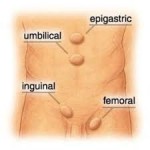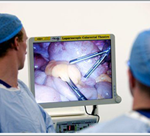What is minimally-invasive hernia repair?
In minimally-invasive hernia repair, a surgeon uses a laparoscope—a thin tube with a tiny video camera at its tip—and small tools to fix a hernia. During all kinds of laparoscopic surgery, the surgeon is guided by images projected on a television monitor.
In many cases, patients recover more quickly from minimally-invasive hernia repair than they do from open hernia repair. The technique leaves only small scars, and may cause less pain than open hernia repair.
Why would a doctor recommend minimally-invasive hernia repair?

Although many hernias are repaired using open surgery, minimally-invasive hernia repair may be appropriate in some cases. A doctor may recommend minimally-invasive hernia repair because:
- It may cause less pain than an open hernia repair
- It may allow the patient to return to work and a normal lifestyle more quickly
- It allows easier repair of double (bilateral) inguinal hernias, where a patient has a hernia on either side of his or her abdomen. The surgeon can repair both hernias using the same three small incisions as for a single hernia repair.
- It can reduce the chances of a ventral hernia re-occurring, and reduce possible complications
Some patients may not qualify for minimally-invasive hernia repair. A doctor may recommend open hernia repair when:
- There has been a previous infection at the site of the hernia
- A patient is obese
- A patient has significant scar tissue from previous abdominal surgery
- The surgeon has trouble seeing the patient’s internal organs with the laparoscope (a thin tube with a video camera at its tip)
- A patient has bleeding problems during the operation
What does minimally-invasive hernia repair involve?
Most inguinal hernia operations are performed on an outpatient basis, which means that you will return home the same day of your surgery. You will not be alert enough to drive on your own after your surgery, so make sure a family member or friend can take you home.
Patients having a ventral hernia repaired may need to stay in the hospital overnight.
You will be given medication by IV, or through a mask, to make you lose consciousness. You will not feel any pain during the surgery, and will not remember the surgery afterward.
Once you are asleep, the surgeon uses carbon dioxide gas to create a space between the wall of your abdomen and the organs inside. Next, he or she makes three small incisions in the skin of your abdomen. The surgeon then passes narrow tubes through these incisions in your abdominal wall. The laparoscope and other instruments will be moved through these tubes during the operation.
The sensor in the tip of the laparoscope allows the surgeon to see images from inside your abdomen on a television monitor. Using tiny tools, the surgeon pushes the hernia back into place with a small piece of surgical mesh, then fastens the mesh in place with surgical staples or sutures. This mesh will help prevent future hernias in the same location.
Once the repair is completed, the surgeon removes the instruments, the laparoscope, and the tubes from your incisions.
To know more about Hernia Repair in India please visit this link : https://safemedtrip.com/medical-services/laparoscopic-minimally-invasive-surgery-in-india/laparoscopic-hernia-surgery-in-india.html

 Click to WhatsApp
Click to WhatsApp +91-9899993637
+91-9899993637




